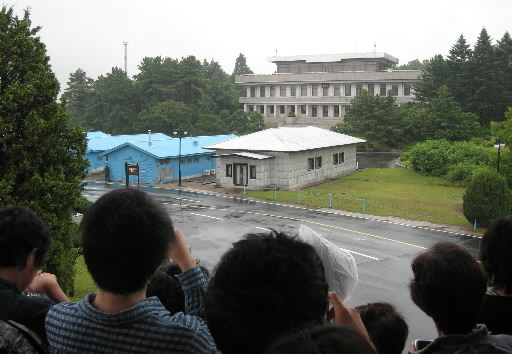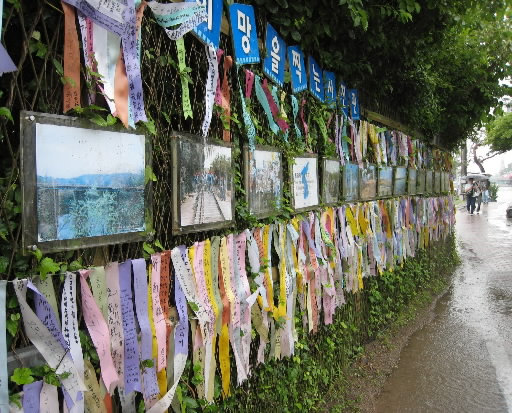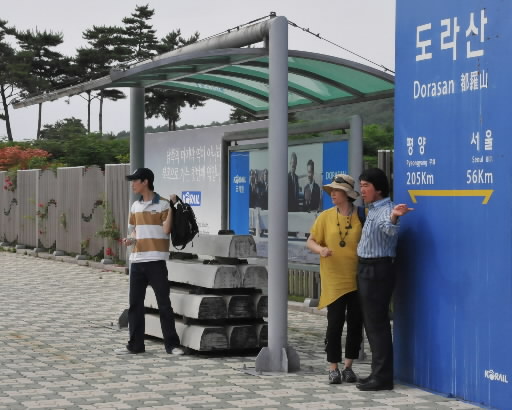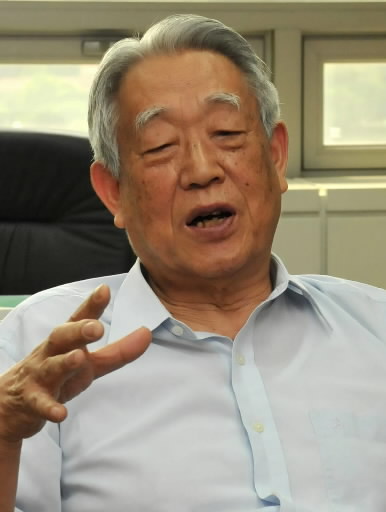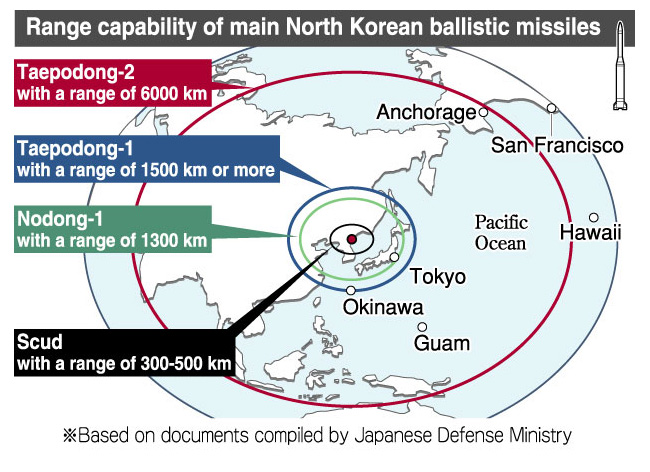Nuclear weapons can be eliminated: Chapter 6, Introduction
Jul. 26, 2009
Chapter 6: Instability in Northeast Asia
Introduction: North Korea’s nuclear weapons development
by Junichiro Hayashi, Staff Writer
The facts surrounding North Korea’s nuclear weapon development program have remained obscure for 50 years. The present focus is on their development of nuclear warheads and the reduction in size of their nuclear weapons as well as the development of missiles on which nuclear warheads can be deployed. How far has North Korea gotten? Based on analyses by experts in South Korea, the Chugoku Shimbun examined the facts, which have been shrouded in secrecy, and the threat North Korea poses.
Five to nine warheads possible, says South Korean expert
During a visit in late June, heavy rain was falling in Panmunjom, 80 kilometers north of Seoul in the Demilitarized Zone. South Korean soldiers assigned to United Nations forces gave strict instructions to tourists participating in the “security tours”: “No waving.” “Form two lines and proceed.”
This is where the ceasefire agreement that brought a halt to hostilities in the Korean War was signed. The histories of the two nations, divided into north and south, began here. North Korea has embarked on a program to develop nuclear weapons, and its every move provokes distrust on the part of its fellow Koreans to the south.
The offices of the government-supported Science and Technology Policy Institute are located on the 26th floor of a building overlooking downtown Seoul. Lee Choon-Geun, 50, leader of the institute’s Inter-Korean Cooperation Team, described the course of North Korea’s nuclear development and its current state, prefacing his remarks with a disclaimer: “This is just conjecture based on bits and pieces of information I have put together.”
According to Mr. Lee, North Korea began developing nuclear weapons in the mid-1950s, sending its scientists to the Soviet Union in an effort to manufacture a plutonium bomb like the one dropped on Nagasaki. There are uranium mines in North Korea, and, when calculated based on uranium oxide, its reserves are estimated to be more than 15,000 tons. Using a nuclear reactor it is producing 5 to 7 kilograms of weapons-grade plutonium per year and has already stockpiled 30 to 50 kilograms, enough for six to 10 nuclear warheads. Taking into account the amount used in its two nuclear tests and the newly reprocessed amount, it is estimated that there is still enough to produce 5 to 9 nuclear warheads.
On June 13 North Korea declared it had started enriching uranium, a simpler bomb technology than that of plutonium. But sophisticated technology that makes use of a centrifuge is required, and Mr. Lee says North Korea has not been able to produce weapons-grade highly enriched uranium.
Mr. Lee bases his suppositions on various facts. North Korea has already gotten 20 centrifuges as well as their design drawings from Pakistan, and reports indicated that in 2002 North Korea imported 150 tons of high-strength aluminum pipe--enough for the manufacture of 2,600 centrifuges--from Russia. But there is no record of North Korea importing the bearings and other precision components necessary for the high-speed rotation of centrifuges, and it is doubtful that North Korea has the ability to produce these parts itself. Thus Mr. Lee does not believe North Korea is prepared to obtain weapons-grade highly enriched uranium.
Meanwhile, how far has North Korea’s development proceeded involving missiles on which nuclear warheads could be deployed? It is believed that its intermediate-range ballistic missile Nodong can carry warheads of up to 1 ton. The range of the missiles is 1,300 kilometers, just about enough to reach Japan.
“Japan is within range,” said Kim Taewoo, 59, vice president of the government-supported Korea Institute for Defense Analyses. “The development of long-range ballistic missiles is targeted at the U.S. so there is no need for Japan to overreact to the development of long-range ballistic missiles.”
On April 5 North Korea conducted a test of a long-range ballistic missile and on April 14 announced its intention to withdraw from the six-party talks. At the same time it warned it would expel inspection teams from the International Atomic Energy Agency (IAEA) and the U.S. And on May 25, free from international monitoring, it conducted its second nuclear test. The first was conducted in October 2006.
Mr. Lee expressed concern that North Korea could also become the source of nuclear proliferation. “There are believed to be about 200 scientists working in the nuclear development program,” he said. “There is a risk that nuclear materials could fall into the hands of terrorist organizations or other countries.”
When will North Korea’s technology reach the level at which its nuclear weapons can be put to use? This question, which is of increasing interest to the international community, was put to Yun Dukmin, 49, a professor at the Institute of Foreign Affairs and National Security. “They have conducted multiple nuclear tests and missile tests, so it is certain that they are steadily approaching the point at which they will be able to deploy their weapons,” he said.
Japan and South Korea are already within range of North Korea’s ballistic missiles, and the performance of the short-range Scud (300 to 500 kilometers) and the medium-range Nodong (1,300 kilometers), including their accuracy, has been enhanced. It is possible that the launch of seven missiles on July 4 included an improved Scud with a range of 1,000 kilometers.
Whether or not North Korea has the ability to launch a nuclear attack on the U.S. is also the subject of debate. Many South Korean experts believe that North Korea will be able to reduce the size of its nuclear warheads and put the Taepodong to practical use within five to 10 years. A senior U.S. military official has said that the west coast of the U.S. will be within range of North Korean missiles within three to five years.
Based on the current status of North Korea’s nuclear warhead and missile development program, Mr. Yun said, “If their nuclear development cannot be stopped, it will be impossible to prevent them from putting the weapons to use.”
Interview with Kang Induk, former South Korea Minister of Unification
Denuclearization through pressure and dialogue
What is the goal of North Korea’s nuclear weapons development program? What should Japan and other neighboring nations do about it? The Chugoku Shimbun interviewed Kang Induk, 76, South Korea’s former Minister of Unification, who has been observing developments in North Korea for 40 years, in Seoul.
What is the goal of North Korea’s nuclear development program?
It’s often said that the goal is to use it as a diplomatic and negotiating card, but actually it’s because they want to be a nuclear nation. In the early stages of their nuclear development in 1968, President Kim Il-sung gave a speech in which he called on North Korea’s nuclear scientists to bomb the U.S. mainland.
With the end of the Cold War and the collapse of the socialist systems in various countries, the future of the North Korean regime was also in jeopardy. In 1994 Kim Il-sung died and was succeeded by his son, Kim Jong-il, who assumed the title of General Secretary of the Workers’ Party of Korea. He has continued to pour money into nuclear weapon development despite a battered economy and a starving populace. His philosophy is a “military-first” government that relies only on weaponry, and the highest level of weaponry is nuclear weapons. That’s why he will never abandon nuclear weapons even if negotiations are held.
What do you think neighboring countries should do?
This won’t make the people of Hiroshima and Nagasaki happy, but under the current circumstances Japan and South Korea have no choice but to rely on the U.S. nuclear umbrella. When North Korea threatens its neighbors with its nuclear capability, some sort of check on its power is necessary, and that doesn’t mean waging war with nuclear weapons. No diplomatic measure other than applying pressure to North Korea can be expected to resolve this issue.
Is there an effective method of diplomacy?
Cooperation with China. Eighty percent of the goods coming into North Korea are made in China. Oil exported from China to North Korea accounts for even more than that percentage. Economic sanctions by China would have a major impact on North Korea. And the message must be conveyed to North Korea via China that the goal of this diplomacy is not to topple the regime of Kim Jong-il and that North Korea has nothing to be gained by developing nuclear weapons.
Do you believe that Northeast Asia can be denuclearized on the basis of dialogue?
Political and diplomatic efforts are the only way to achieve a peaceful resolution. Based on our dialogues with North Korea since the 1970s, we must also pay attention to the language we use politically. We often refer to the “denuclearization of the Korean peninsula,” but when we do that we open to the door to North Korea to assert that the nuclear weapons of the U.S., which is an ally of both South Korea and Japan, must be eliminated and that the alliance itself must be dissolved.
At the same time we must find a way to eliminate the hostile policies of the U.S. and North Korea toward one other, such as through the normalization of diplomatic ties. A peaceful resolution to the situation will require a lot of time and effort, but if we conduct negotiations with vague language and an ambivalent attitude, the two sides will remain at odds.
Kang Induk
Born in November 1932 in Pyongyang. Graduated from the graduate school of Hankuk University of Foreign Studies in 1968. Through 1978 held various posts in the Korea Central Intelligence Agency (KCIA), including head of the North Korea Department. Established the Institute for Far Eastern Studies in 1979 and is its director. Served as Minister of Unification from 1998 to 1999.
Timeline of the Development of Nuclear Weapons by North Korea
(Based on materials provided by the Japan Institute of International Affairs and other sources)
June 1950: Korean War begins.
July 1953: North and South Korea sign ceasefire agreement.
Sept. 1974: North Korea joins International Atomic Energy Agency (IAEA).
Dec. 1985: North Korea joins Nuclear Non-proliferation Treaty (NPT).
Jan. 1986: Nuclear reactor at Yeongbyeon goes into operation.
April 1991: Kim Il-sung delivers speech at meeting of Inter-Parliamentary Union (IPU), stresses denuclearization of Korean peninsula and promotion of dialogue between North and South Korea.
July 1991: At IAEA headquarters North Korea provisionally agrees to undergo nuclear inspections.
North Korea proposes joint declaration calling for denuclearization of the Korean peninsula.
Sept. 1991: IAEA Board of Governors passes resolution asking North Korea to sign and implement a draft agreement for security measures (nuclear inspections). North Korea delegate declines to sign citing U.S. nuclear weapons in South Korea. Oct. 1991: At a meeting of the United Nations General Assembly, North Korea Premier Yeon Hyeong-muk declares North Korea’s willingness to sign an agreement for nuclear inspections if the U.S. removes its nuclear weapons from South Korea.
Dec. 1991: South and North Korea agree on a joint declaration on the denuclearization of the Korean peninsula. Exchange documents in Jan. 1992.
Jan. 1992: North Korea signs agreement with IAEA for nuclear inspections.
Feb. 1992: Robert Gates, U.S. Director of the Central Intelligence Agency (CIA), says North Korea is continuing to develop nuclear weapons and will have the capability to manufacture nuclear weapons within a few months to a few years.
April 1992: Safeguards agreement with IAEA ratified.
May 1992: Initial report on nuclear facilities and nuclear materials submitted to IAEA. IAEA inspection enters North Korea.
March 1993: North Korea opposes IAEA inspections, warns U.N. Security Council that it will leave the NPT framework.
Nov. 1993: U.N. General Assembly adopts first resolution urging North Korea to accept inspections by IAEA.
Feb. 1994: Agreement reached on inspection of seven declared nuclear facilities.
March 1994: IAEA releases declaration stating that a major inspection of the radiochemistry laboratory at Yeongbyeon was refused.
April 1994: Kim Il-sung denies that North Korea possess nuclear weapons.
May 1994: North Korea warns that it has begun replacing the nuclear fuel rods in an experimental reactor without IAEA observation.
June 1994: North Korea warns U.S. government that it will leave IAEA; puts departure from NPT framework on hold.
Oct. 1994: U.S. and North Korea formally sign agreement to create a mechanism to improve relations between the two nations that includes provisions for a freeze on North Korea’s nuclear development.
March 1995: U.S., Japan and South Korea sign agreement creating the Korean Peninsula Energy Development Organization (KEDO), and it is formally launched.
May 1999: Team of U.S. experts conducts first inspection of North Korea’s special weapons facilities at Kumchangni, suspected to be an underground nuclear facility. Team reports that no nuclear-related facilities were found.
Aug. 2002: KEDO begins construction of facility to house light water reactor.
Sept. 2002: Japan-DPRK Pyongyang Declaration is signed at a summit with leaders of the two nations.
Nov. 2002: Executive Board of KEDO resolves to put a freeze on the provisions of fuel oil from the U.S. as long as North Korea fails to abandon its plans to develop nuclear weapons.
Dec. 2002: In response to the halt to shipments of fuel oil, North Korea declares that it will resume its nuclear development. Two IAEA inspectors leave Pyongyang.
Jan. 2003: North Korea withdraws from NPT and declares that it will break off safeguards agreement with the IAEA.
Feb. 2003: North Korea resumes operation of graphite-moderated reactor.
Aug. 2003: First phase of six-party talks
Oct. 2003: North Korea’s Foreign Ministry declares that it has safely completed the reprocessing of 8,000 spent nuclear fuel rods.
Jan. 2004: In his State of the Union address, U.S. President George W. Bush refers to North Korea and Iran as the world’s “most dangerous regimes.”
Feb. 2004: Abdul Qadeer Khan, a Pakistani nuclear scientist, reveals that he provided technology for the enrichment of uranium to North Korea.
Feb. 2005: Through its Korean Central News Agency, North Korea reveals for the first time that it possesses nuclear weapons, declaring that it has manufactured them for its self-defense.
May 2006: Executive board of KEDO formally resolves to abandon the project to build a light water reactor in North Korea.
Oct. 2006: North Korea announces that it has successfully conducted its first underground nuclear test.
Feb. 2007: In the fifth phase of the six-party talks, it is agreed to cease operations at the nuclear facilities at Yeongbyeon and close them, to accept IAEA inspections, and to begin providing 50,000 tons of fuel oil to North Korea.
June 2008: North Korea demolishes the cooling tower for the graphite-moderated reactor used for testing at Yeongbyeon.
July 2008: In a nuclear declaration delivered to China, North Korea reveals that it has extracted a total of 38.5 kg of plutonium and that it has used 25.5 kg of that for nuclear weapons.
Aug. 2008: North Korea’s Foreign Ministry criticizes the U.S. decision to postpone rescinding its designation of North Korea as a state sponsor of terrorism, saying that it will suspend disabling its nuclear facilities in Yeongbyeon.
Oct. 2008: The U.S. State Department announces that it has rescinded its designation of North Korea as a state sponsor of terrorism.
Jan. 23, 2009: Kim Jong-il meets with Wang Jiarui, director of the International Department of the Central Committee of the Communist Party of China, and declares that he will cooperate in the denuclearization of the Korean Peninsula.
April 5, 2009: North Korea launches a missile saying that it is a satellite.
April 14, 2009: North Korea declares that it will no longer participate in the six-party talks.
May 25, 2009: North Korea conducts its second nuclear test.
June 13, 2009: North Korea begins uranium enrichment and declares all of its plutonium will be used for weapons.
July 4, 2009: Seven ballistic missiles are launched into the Sea of Japan.
(Originally published on July 11, 2009)
To comment on this article, please click the link below. Comments will be moderated and posted in a timely fashion. Comments may also appear in the Chugoku Shimbun newspaper.

